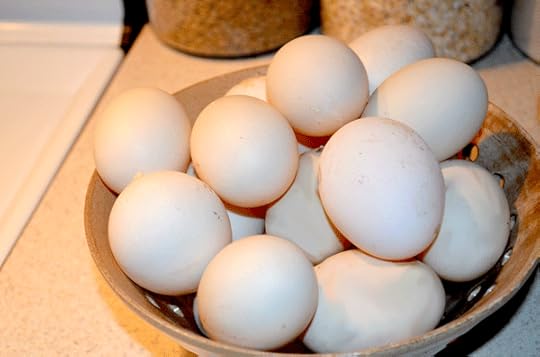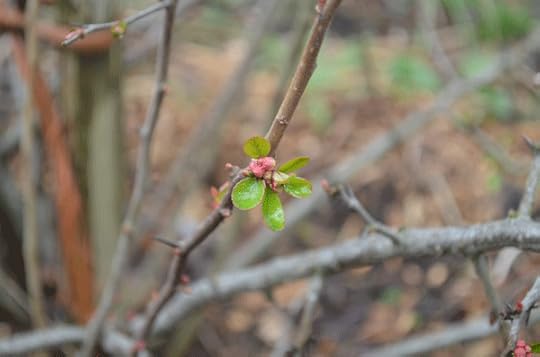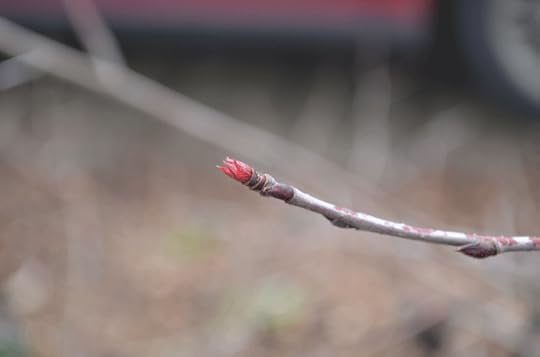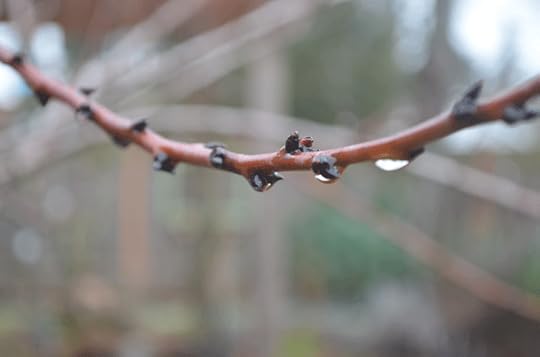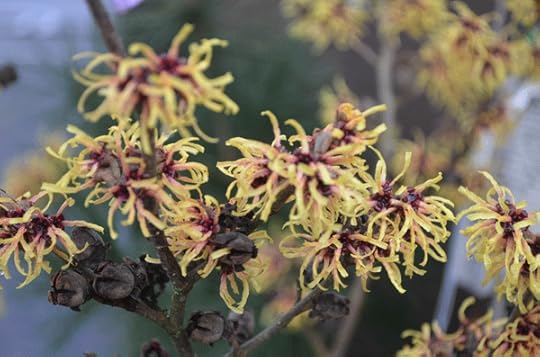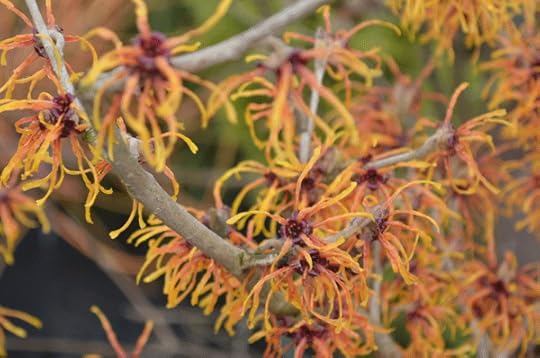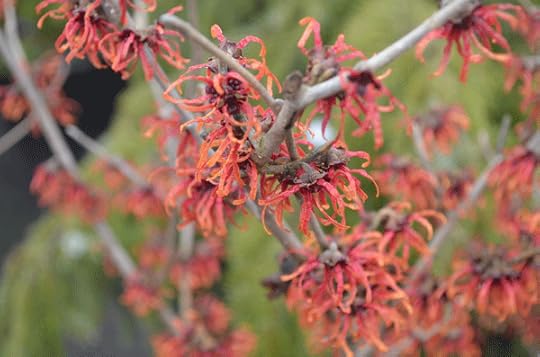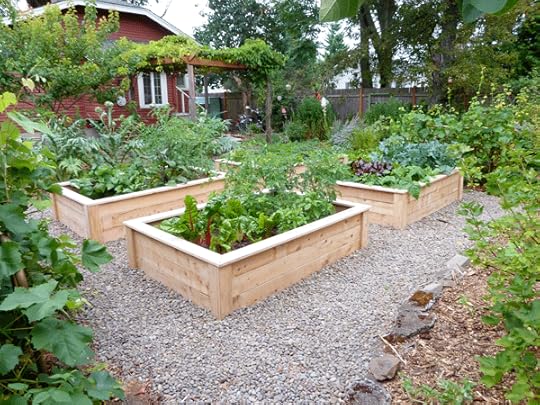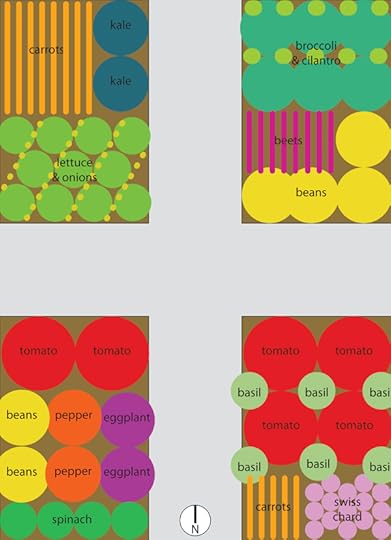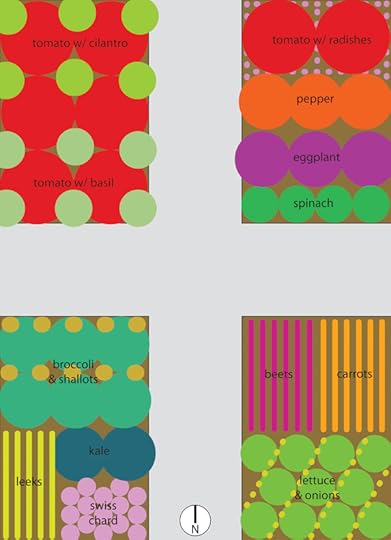Renee Wilkinson's Blog, page 18
March 13, 2013
Country Gardens Magazine Article
Run, don’t walk, to grab your Spring 2013 copy of Country Gardens magazine (on sale March 12th). I wrote an article for this issue all about my journey through modern homesteading. They did a fabulous photo shoot of our homestead, so you can enjoy all kinds of gorgeous garden inspiration.
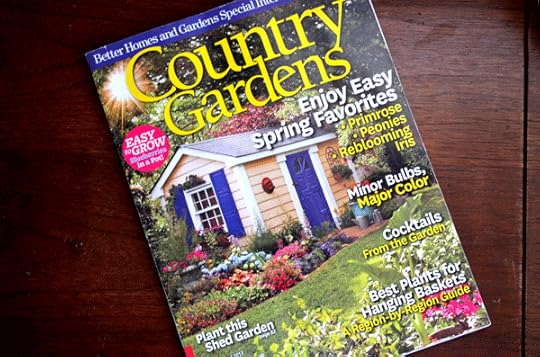 I am so giddy to be a part of this national publication. James Bagget, the publisher, was a treat to work with and Nick Crow, the art director, made sure every photo sung the praises of our homestead. He even managed to get a sleepy Juniper to crack a cute smile during the shoot.
I am so giddy to be a part of this national publication. James Bagget, the publisher, was a treat to work with and Nick Crow, the art director, made sure every photo sung the praises of our homestead. He even managed to get a sleepy Juniper to crack a cute smile during the shoot.
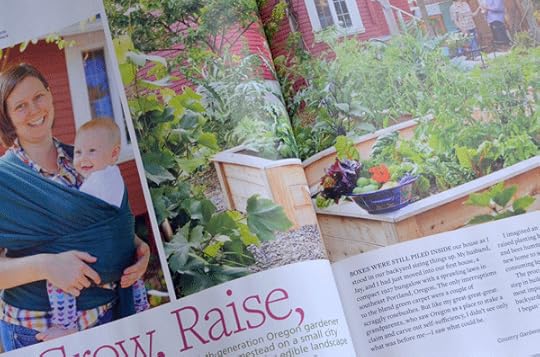 Juniper was only about six months when they came this summer to shoot the garden. Friends really helped me pull every last weed and Jay made sure there wasn’t a spot of manure in the chicken and duck coops. Boy, it really does take a village.
Juniper was only about six months when they came this summer to shoot the garden. Friends really helped me pull every last weed and Jay made sure there wasn’t a spot of manure in the chicken and duck coops. Boy, it really does take a village.
I wrote about the passion I discovered digging in the soil and how the garden has exploded into something more beautiful than I could have imagined – all just in time to get your garden ambition sufficiently pumped for the season ahead! You can see six stunning pages of photos from our homestead, along with my vegetable planting plan for the four raised beds – something anyone can use in their own garden.
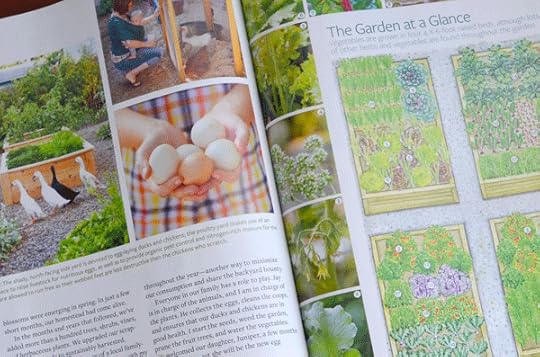 My greatest hope is that the article leaves readers feeling inspired to get their hands dirty growing their own food this year. And, of course, I hope it’s one of their best selling issues! I would love to see more national gardening publications covering edible landscaping, modern homesteading and all that jazz. I’d love to hear what you think of the article!
My greatest hope is that the article leaves readers feeling inspired to get their hands dirty growing their own food this year. And, of course, I hope it’s one of their best selling issues! I would love to see more national gardening publications covering edible landscaping, modern homesteading and all that jazz. I’d love to hear what you think of the article!
March 11, 2013
Recipe: Crab Frittata
We snagged a beach house for the weekend with an amazing ocean view to show off the Pacific Northwest to family visiting from out of town. It was near the small coastal town of Cannon Beach in Oregon, a community studded with art galleries, coffeeshops, a brew pub and a great fish market.
 It just so happens that the market owns their own crabbing boats – my favorite shellfish – which meant we could stock up on freshly caught Dungeness crab at a good price. After a stop at the local wine shop for some local pinot gris, we headed back to the house and stuffed ourselves with these jewels from the ocean.
It just so happens that the market owns their own crabbing boats – my favorite shellfish – which meant we could stock up on freshly caught Dungeness crab at a good price. After a stop at the local wine shop for some local pinot gris, we headed back to the house and stuffed ourselves with these jewels from the ocean.
 Around sunset, we had all reached the limit on our waistlines, but a huge pile of crab still remained. What to do with the leftovers? I pondered this question the next day as we drove home, unpacked the car and settled back in.
Around sunset, we had all reached the limit on our waistlines, but a huge pile of crab still remained. What to do with the leftovers? I pondered this question the next day as we drove home, unpacked the car and settled back in.
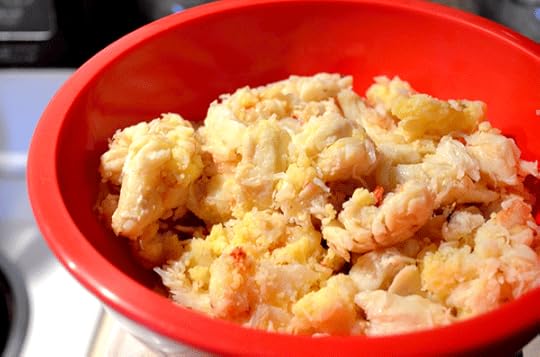 That evening, Jay came in the backdoor with a huge bowl of eggs from the ducks, answering my question. It would be made into a duck egg and crab frittata.
That evening, Jay came in the backdoor with a huge bowl of eggs from the ducks, answering my question. It would be made into a duck egg and crab frittata.
olive oil
1 small onion, thinly sliced
6 eggs (chicken or duck)
2 garlic cloves, minced
1/4 c. roasted red bell pepper, chopped
1 lb. lump crab meat
1/4 tsp. old bay seasoning
Preheat the oven to 350 degrees. Meanwhile, warm 1 T. olive oil in a large skillet over medium heat. Add the onion and simmer until softened, about five minutes.
In a medium bowl, beat the eggs with garlic, red bell pepper, lump crab meat, old bay seasoning and salt/pepper to taste (go light as the old bay will have salt as well). Add sauteed onions and mix to combine.
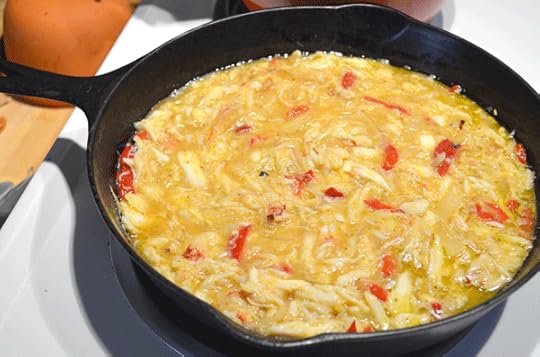 Warm 2 T. more olive oil in the skillet. Then add the egg mixture and let it cook over medium-low heat. Gently run your spatula around the edges as the eggs start to set, letting the uncooked egg get underneath.
Warm 2 T. more olive oil in the skillet. Then add the egg mixture and let it cook over medium-low heat. Gently run your spatula around the edges as the eggs start to set, letting the uncooked egg get underneath.After the mixture begins to set (about 5 minutes), move the skillet into the preheated oven and bake for 10-15 minutes more. Once set, enjoy warm or cold!
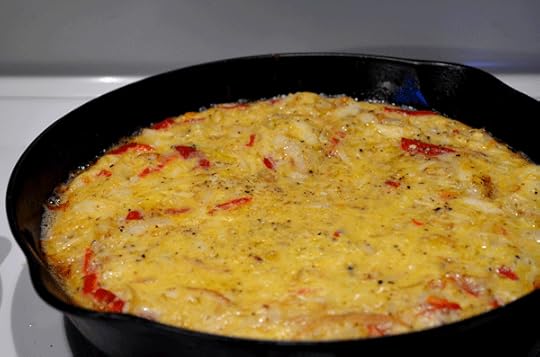 The best thing about this frittata is that it showcases the crab meat and is very filling. The seafood flavor is not masked by complicated ingredients. In fact, the eggs really act as a binder – just holding the tender crab meat together.
The best thing about this frittata is that it showcases the crab meat and is very filling. The seafood flavor is not masked by complicated ingredients. In fact, the eggs really act as a binder – just holding the tender crab meat together.
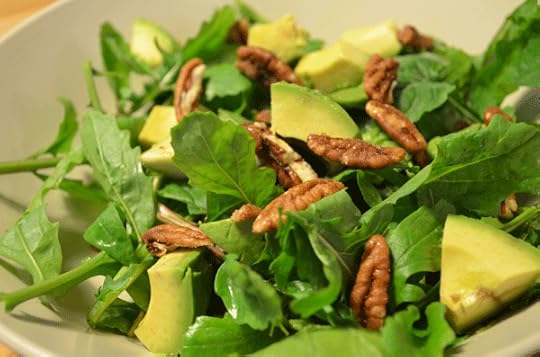 Serve it for dinner with a huge arugula salad tossed with chunks of avocado, candied pecans and sprinkled with lemon juice. The thickness of the arugula leaves and creaminess of the avocado pairs perfectly with the crab meat.
Serve it for dinner with a huge arugula salad tossed with chunks of avocado, candied pecans and sprinkled with lemon juice. The thickness of the arugula leaves and creaminess of the avocado pairs perfectly with the crab meat.
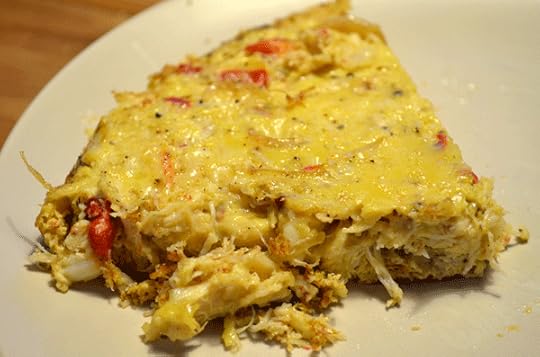 When it’s the main course, I would say it feeds four. If you serve it as a side or with other hearty dishes, then plan to serve 6-8 people. It’s great the next day cold for breakfast or on bread as a sandwich at lunch.
When it’s the main course, I would say it feeds four. If you serve it as a side or with other hearty dishes, then plan to serve 6-8 people. It’s great the next day cold for breakfast or on bread as a sandwich at lunch.
March 5, 2013
A Year of Motherhood
Why haven’t I started my indoor seeds yet? Because I have been too busy celebrating a year of motherhood with my little Leapling, Juniper. She came into the world on February 29th last year as the snow was gently falling.
 I remember the first walk we took to the park in our neighborhood when she met Winter Daphne, one of my favorite early blooming flowers. There we were in the same park, smelling the same fragrant blossoms this past weekend as we celebrated her (sort of) birthday.
I remember the first walk we took to the park in our neighborhood when she met Winter Daphne, one of my favorite early blooming flowers. There we were in the same park, smelling the same fragrant blossoms this past weekend as we celebrated her (sort of) birthday.
 We are making lots of memories along the Oregon coast this winter and catching lots and lots of sunsets.
We are making lots of memories along the Oregon coast this winter and catching lots and lots of sunsets.
 She is helping me gobble up all of the fruits we froze for winter. Favorites include Italian plum halves and juicy blueberries. This is the face of a happy berry eater!
She is helping me gobble up all of the fruits we froze for winter. Favorites include Italian plum halves and juicy blueberries. This is the face of a happy berry eater!
 I’ve learned to let things go in a good way, to forgive myself for not being perfect, and accept that it’s okay to let a little chaos into our lives.
I’ve learned to let things go in a good way, to forgive myself for not being perfect, and accept that it’s okay to let a little chaos into our lives. 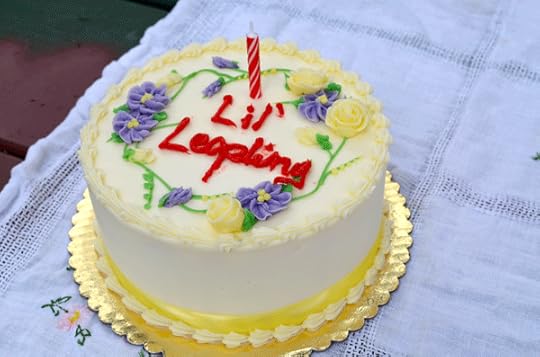
Seeds can wait, but birthday’s can’t.
February 26, 2013
Time to Wake Up
It’s still pretty grey in Portland in late February, but a careful eye in the garden shows signs of spring at every turn. Here are some promises of spring I am noticing in the garden.
Quince buds
Our flowering quince shrubs have buds at the brink of opening. Quince will mostly set fruit on woody stems developed in the previous year. As much as I love indoor cut flowers, I won’t risk missing out on fruit by sacrificing a stem of flowers for indoor enjoyment. Instead, they will bloom naturally outside while I hover over them waiting for signs of fruit setting.
Aronia leaves emerging
The aronia has matured into a small, graceful shrub. Mid-spring will bring white flowers followed by dark berries in late summer. It puts on a spectacular show in the fall when the leaves turn scarlet. Right now it’s hinting at spring with it’s bright new leaves emerging.
Counting my apricots before the buds have even opened
Apricots, along with plums and cherries, are early spring bloomers that put on a spectacular show. Every day the buds swell just a bit bigger. I did my last round of spraying with an organic copper treatment to protect it from blight. There should be a massive harvest this year and I can hardly wait!
My “river” of blue irises in the front garden
I rearranged the front garden this winter with propogated plants. The irises are already off to a running start and I will be sure to post pictures throughout the season. Right now the newly cut and dividing plants are too small to really notice. But get ready – with wet weather and a few weeks of sun it will explode with life.
Do you have plants already putting on a spring show? How is your garden telling you spring is near?
February 20, 2013
Recipe: Lemon Butter
My indoor Meyer lemon tree gave me a small harvest this year and the fruit is far too special to make into just any old dish. I decided to make a simple lemon butter to savor every ounce of flavor – unadulterated. The end product is a bright, creamy and versatile spread that shows off the homegrown flavor of my citrus fruit.
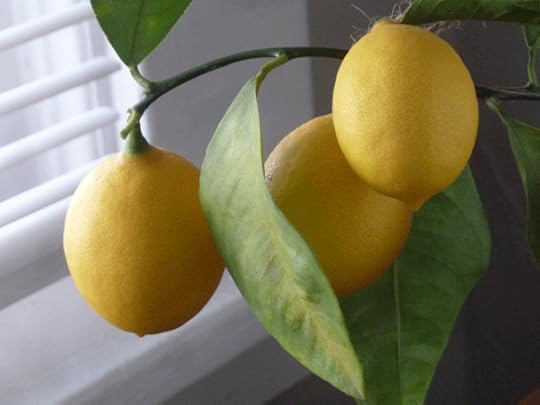 I used Meyer lemons, but any old lemon will do. Meyer lemons have a thinner peel, so you are growing mostly juicy fruit. They are also a bit sweeter than your run-of-the-mill tart lemon. I began with this recipe, although I modified it for a stronger lemon taste.
I used Meyer lemons, but any old lemon will do. Meyer lemons have a thinner peel, so you are growing mostly juicy fruit. They are also a bit sweeter than your run-of-the-mill tart lemon. I began with this recipe, although I modified it for a stronger lemon taste.
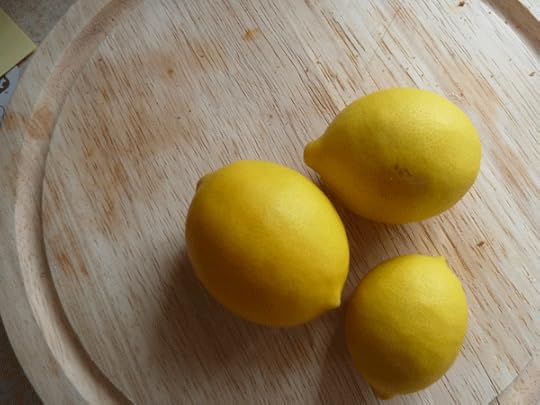 Start by zesting one medium lemon, making sure you don’t cut off the white bitter pith. Next, juice every drop you can squeeze from the fruit.
Start by zesting one medium lemon, making sure you don’t cut off the white bitter pith. Next, juice every drop you can squeeze from the fruit.
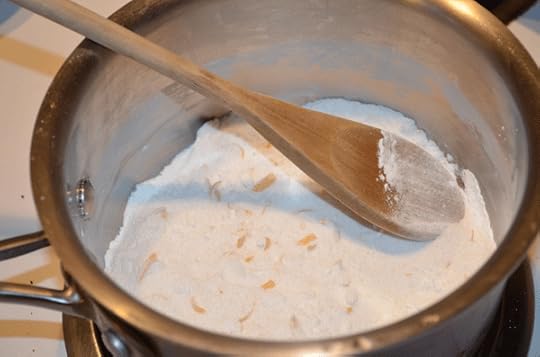 In a small saucepan, mix your dry ingredients: all of the lemon zest, 1/4 cup of white sugar and 1 tsp of cornstarch. Then add your wet ingredients: 1/4 cup of water and the lemon juice. Stir to dissolve and begin cooking over medium heat.
In a small saucepan, mix your dry ingredients: all of the lemon zest, 1/4 cup of white sugar and 1 tsp of cornstarch. Then add your wet ingredients: 1/4 cup of water and the lemon juice. Stir to dissolve and begin cooking over medium heat.
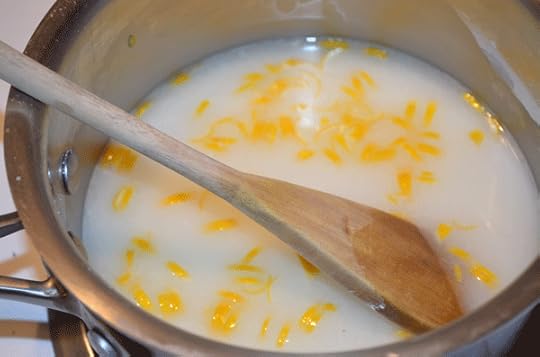 As the mixture begins to boil, continue stirring for a couple more minutes. Remove from heat and stir in two tablespoons of butter. When that has melted, you are ready to serve!
As the mixture begins to boil, continue stirring for a couple more minutes. Remove from heat and stir in two tablespoons of butter. When that has melted, you are ready to serve!
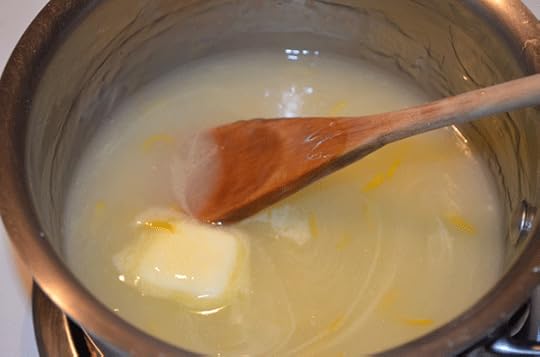 We enjoyed the first batch over hot waffles, although it’s just as great slathered over pancakes, muffins, etc. We stored the leftovers in the fridge and enjoyed the chilled lemon butter over vanilla ice cream. You can also top a cheesecake with this delicious sauce or even goat cheese.
We enjoyed the first batch over hot waffles, although it’s just as great slathered over pancakes, muffins, etc. We stored the leftovers in the fridge and enjoyed the chilled lemon butter over vanilla ice cream. You can also top a cheesecake with this delicious sauce or even goat cheese.
 The lemon butter will keep in the fridge in an airtight container for one week, possibly longer. It was the perfect way to showcase our homegrown fruit and a lovely addition to our winter meals.
The lemon butter will keep in the fridge in an airtight container for one week, possibly longer. It was the perfect way to showcase our homegrown fruit and a lovely addition to our winter meals.
February 12, 2013
Winter Blooming Witch Hazel
It’s the beginning of a new gardening season and already I see blooming plants that I wish I could make room for in my garden. On a recent afternoon, I took a tour of my favorite local nursery to admire their many varieties of winter blooming witch hazel.
Winter blooming Pallida Chinese Witch Hazel, or Hamamelis mollis ‘Pallida’
You will generally find three varieties of witch hazel: the North American native called Hamamelis virginiana, the Chinese version called Hamamelis mollis, or the ornamental hybrid Hamamelis x intermedia. The North American native version blooms in the fall, is incredibly fragrant and has a host of medicinal uses. Both the Chinese version and hybrid are gorgeous, winter-blooming plants.
Winter blooming Jelena Witch Hazel, or Hamamelis x intermedia ‘Jelena’
Witch hazels typically grow as large deciduous shrubs or small trees. The native version grows as an understory tree – perfect to place under a large shade tree – while the Chinese and hybrid versions can tolerate full sun.
Hamamelis virginiana is native to the southeast and northeastern part of North America, with flowers range from yellow to orange. You will most often find the Chinese version ‘Pallida’ at your nursery, which has bright yellow ribbon-like petals with red centers. The hybrids range from yellow to blazing orange to deep red.
Winter blooming Diana Witch Hazel, or Hamamelis x intermedia ‘Diana’
Are you planning to add to your garden this coming year? Of course! Every garden is a work in progress, right? Start planning your shopping list now by keeping a flower calendar. Write down which flowers and foliage are catching your eye each month. That will help you design a lively garden that will give you interest all year long. I would be surprised if a fall or winter blooming witch hazel didn’t make your list.
My list is a mile long, so my goal is always to find room for just one more plant… I’m not sure I can squeeze a winter-blooming witch hazel into the homestead, but that won’t stop me from inspecting every nook and cranny just a bit closer in the hopes that I can find the perfect spot.
February 6, 2013
Vegetable Garden Plan
My gardening ambition grows with every year, increasing the pressure to maximize every inch of gardening space. Climbing peas and beans grow on teepees among the fruit trees and berry bushes, while squash and melons lumber along the ground shading the soil. Aside from these space-gobblers, most of our vegetables are grown in four gorgeous raised beds.
Raised beds circa July 2012
The beds came from NaturalYards, a local Oregon company, and each measure 4′ x 6′. That gives me just shy of 100′ of growing space in the raised beds. It’s hard to juggle good crop rotation while cramming in enough produce to feed our family, so typically every year I make a garden plan to keep me organized.
2012 raised bed garden plan
After looking at last year’s plan, I made some changes for 2013. First, I am rotating what grows where. Different plants sap different nutrients from the soil, so good crop rotation will help keep the soil balanced. It may also cut down a bit on disease to move them to a new spot, in case the bad guys try to overwinter in the soil.
Next, I’m thinking about what we were overwhelmed with last year vs. what we were able to preserve. We didn’t get enough tomatoes, peppers and eggplants last year, so more this time around. The bush beans weren’t worth the space, since I can more efficiently grow them vertically around the garden. And somehow I missed planting leeks last year?!? They are versatile for year round harvesting, along they take time to mature, so I’m planting lots this year.
2013 raised bed garden plan
Finally, our beds are all pretty filled right now with winter vegetables. Winter crops to be harvested in early spring, like rutabaga, will be replaced with cool weather crops like kale and chard. Other winter veggies won’t be pulled until late spring, like celery and carrots, right when it’s time to transplant in a whole bed of tomatoes.
It pays to be strategic about your garden plan, especially with limited space. Take these chilly evenings to pour over your seed collection and draw out your plan. Leave enough room for each plant to reach their mature size, think about companion planting (planting onions in between lettuces, etc), and get those seeds started!
January 30, 2013
January Harvest
It has been a cold, dry January thus far – at least it seems that way to me. Some of the crops that typically overwinter uncovered have been barely hanging on. This chilly swiss chard is one example. The plants are still alive, but we won’t be harvesting them until it warms up enough for them to leaf out more.
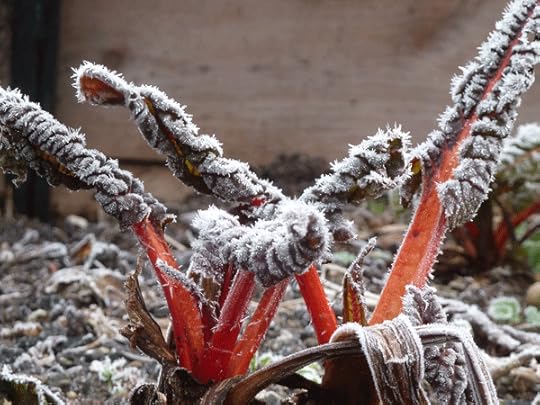 Inside, a not-super-sunny-window is providing just enough light for our meyer lemon tree to ripen. My citrus trees all move inside for winter and we usually harvest just enough fruit for something special.
Inside, a not-super-sunny-window is providing just enough light for our meyer lemon tree to ripen. My citrus trees all move inside for winter and we usually harvest just enough fruit for something special.
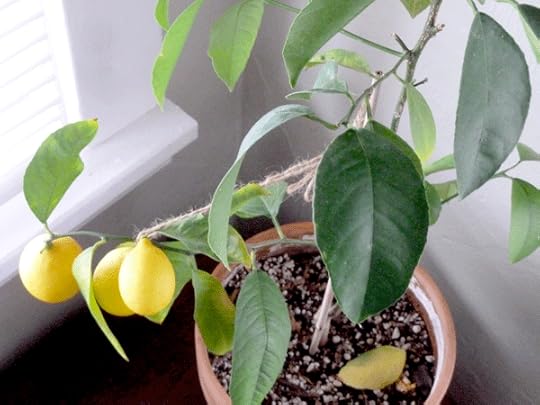 These lemons are destined to become tasty lemon butter for pancakes this weekend. A jolt of tangy citrus will be most welcome on my winter taste buds.
These lemons are destined to become tasty lemon butter for pancakes this weekend. A jolt of tangy citrus will be most welcome on my winter taste buds.
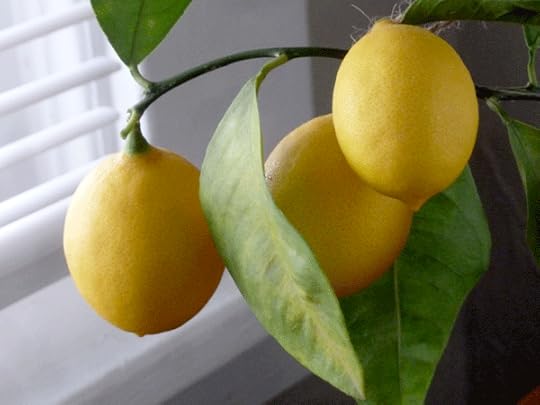 Two of our vegetable beds are covered this winter. The one shown below has been providing us a steady stream of salad greens, mostly arugula inter-planted with onions. Half of this bed still holds our summer carrots. We pull them out as needed through the winter months.
Two of our vegetable beds are covered this winter. The one shown below has been providing us a steady stream of salad greens, mostly arugula inter-planted with onions. Half of this bed still holds our summer carrots. We pull them out as needed through the winter months.
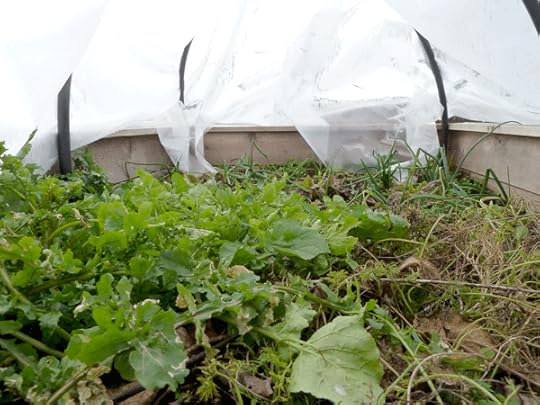 I can’t seem to get out to harvest our dinner veggies before the sun drops. Lately I have been digging around with cold fingers to find roots big enough to pull out. I’m grateful we still have things to pull!
I can’t seem to get out to harvest our dinner veggies before the sun drops. Lately I have been digging around with cold fingers to find roots big enough to pull out. I’m grateful we still have things to pull!
 It’s already time to place seed orders for the coming growing season. I’m just not there yet… I still want a couple more weeks to pour over catalogs and make my final selections. I would love to hear about what you are harvesting this winter and what your plans are for seeds this spring!
It’s already time to place seed orders for the coming growing season. I’m just not there yet… I still want a couple more weeks to pour over catalogs and make my final selections. I would love to hear about what you are harvesting this winter and what your plans are for seeds this spring!
January 24, 2013
Wintertime Chicken & Duck Care
I am fortunate to live in the mild climate of the Pacific Northwest, but even we have had some pretty chilly days of late. When the temperature dips around or below freezing, the backyard birds need a little extra care.
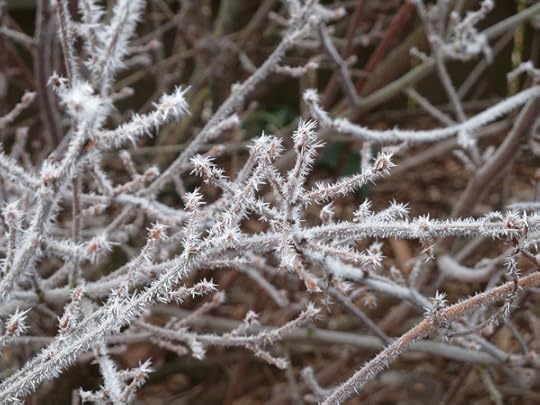 There are water warming trays on the market for backyard livestock, which come in handy in a cold climate. I have never quite gotten around to buying one though – plus they are pricey. So that means that our winter mornings have started out with a cold walk to the coops to thaw the drinking water.
There are water warming trays on the market for backyard livestock, which come in handy in a cold climate. I have never quite gotten around to buying one though – plus they are pricey. So that means that our winter mornings have started out with a cold walk to the coops to thaw the drinking water.
 It has become a nice routine though – something to get me out of the house to breath in the crisp air and take care of our flock. We fill a bucket with warm water from the tap, then make the quiet walk outside to visit the birds each morning. We melt the drinking water and refill it with clean, lukewarm water.
It has become a nice routine though – something to get me out of the house to breath in the crisp air and take care of our flock. We fill a bucket with warm water from the tap, then make the quiet walk outside to visit the birds each morning. We melt the drinking water and refill it with clean, lukewarm water.
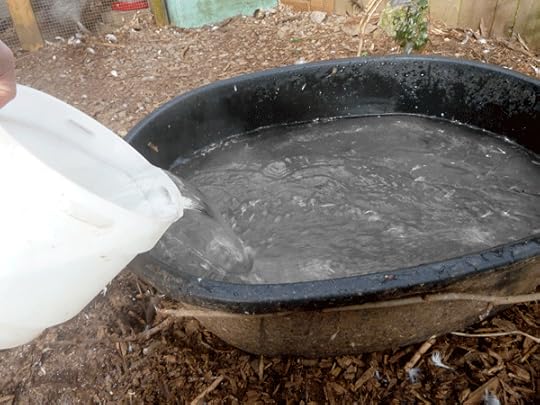 The water in the duck pool has also been frozen each morning. Although our runner ducks don’t require a swimming pool, it makes them so much happier to be able to take a dip, drink and bath. I have been boiling a kettle in the morning, then pouring it in to melt the ice. It’s barely warm to the touch after all the ice disappears and the pool party quickly commences.
The water in the duck pool has also been frozen each morning. Although our runner ducks don’t require a swimming pool, it makes them so much happier to be able to take a dip, drink and bath. I have been boiling a kettle in the morning, then pouring it in to melt the ice. It’s barely warm to the touch after all the ice disappears and the pool party quickly commences.
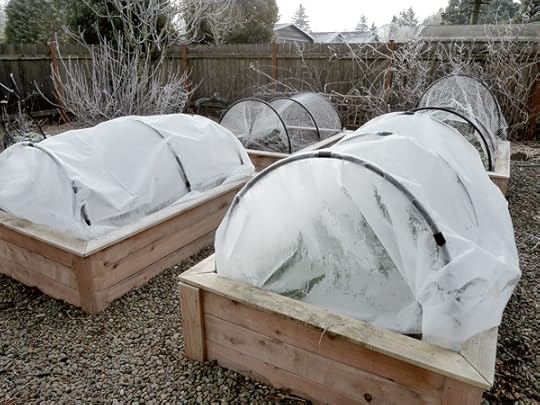 Since most of the garden is sleeping, the chickens and ducks have been given full access to the garden. The beds are covered, so they can’t do any damage to our winter crops. Instead, they till the soil, root around for bugs, lay down some fresh manure and soak up some sunshine. It seems to be a “win” for everyone.
Since most of the garden is sleeping, the chickens and ducks have been given full access to the garden. The beds are covered, so they can’t do any damage to our winter crops. Instead, they till the soil, root around for bugs, lay down some fresh manure and soak up some sunshine. It seems to be a “win” for everyone.
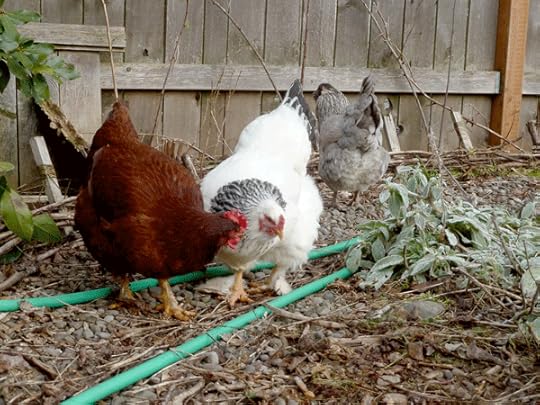 No one is laying eggs as of a couple weeks ago, which is fine by us. You can always force them to lay by placing a light in the coops on a timer to trick them into thinking there is more daylight. But, just like humans, these ladies are only born with so many eggs to lay in their lifetime. We prefer to let them take a rest for the winter, then start back up laying in the spring. That just means we will have more years of eggs from them.
No one is laying eggs as of a couple weeks ago, which is fine by us. You can always force them to lay by placing a light in the coops on a timer to trick them into thinking there is more daylight. But, just like humans, these ladies are only born with so many eggs to lay in their lifetime. We prefer to let them take a rest for the winter, then start back up laying in the spring. That just means we will have more years of eggs from them.
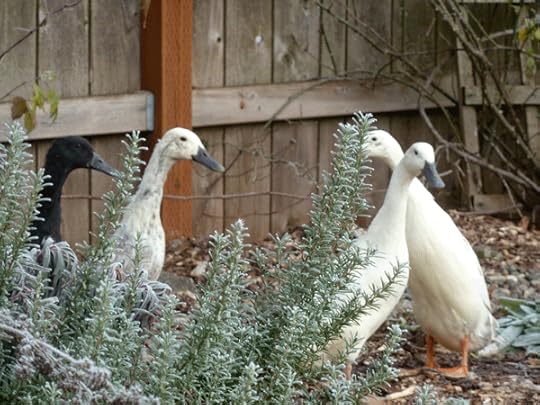 Spring really is just around the corner. Soon my little wintertime routine will come to an end, replaced with a new garden chore, and I will look back longingly at these quiet, sleepy days on the homestead.
Spring really is just around the corner. Soon my little wintertime routine will come to an end, replaced with a new garden chore, and I will look back longingly at these quiet, sleepy days on the homestead.
January 21, 2013
Book Review: Plant-Driven Design
One of the best winter gardening activities is actually spent indoors, reading all those gardening books you never have time to get to in the growing season. I have wanted to share a few titles that I have been reading lately. Disclaimer: I am not receiving any incentive to write this review, but the book link will take you to my Amazon store page. If you buy something from that store page, my family gets a small kickback.
 Plant-Driven Design: Creating Gardens That Honor Plants, Place and Spirit is one of my new all-time favorite garden books. It was written by Steve and Lauren Springer Ogden, who have written other books and are beautiful designers in their own right. But before you run out and buy this book, beware that this is not a book to be loved by everyone.
Plant-Driven Design: Creating Gardens That Honor Plants, Place and Spirit is one of my new all-time favorite garden books. It was written by Steve and Lauren Springer Ogden, who have written other books and are beautiful designers in their own right. But before you run out and buy this book, beware that this is not a book to be loved by everyone.
This book will appeal to landscape architects and very serious designers. This is not a “put this plant here” type design book with planting plans and flowering plant lists. Most of the negative reviews I read were from people who misunderstood the audience for this book and the writers’ approach.
That said, they do include several plant lists like “Conifers deserving more use” or “Woody plants with precocious flowers”. Not exactly mainstream planting lists, but something I lapped up. They tackle interesting topics like designing within microclimates, designing plants to capture light (either rising or setting sun), looking to nature to guide us toward plant communities, using plants to give us a sense of place, etc. The photos are gorgeous, inspiring and educational. It’s a book I will keep and use for decades in my journey as a landscape designer.
Designing edible landscapes is not something covered by this book, but rarely if ever have a seen an edibles-only garden that looks decent. Even my garden still has a fair share of ornamental plants as a backdrop or compliment to the edible plantings. If you are looking for not-your-run-of-the-mill design inspiration or just a book for the plant nerd in your life, you might consider this gem.

